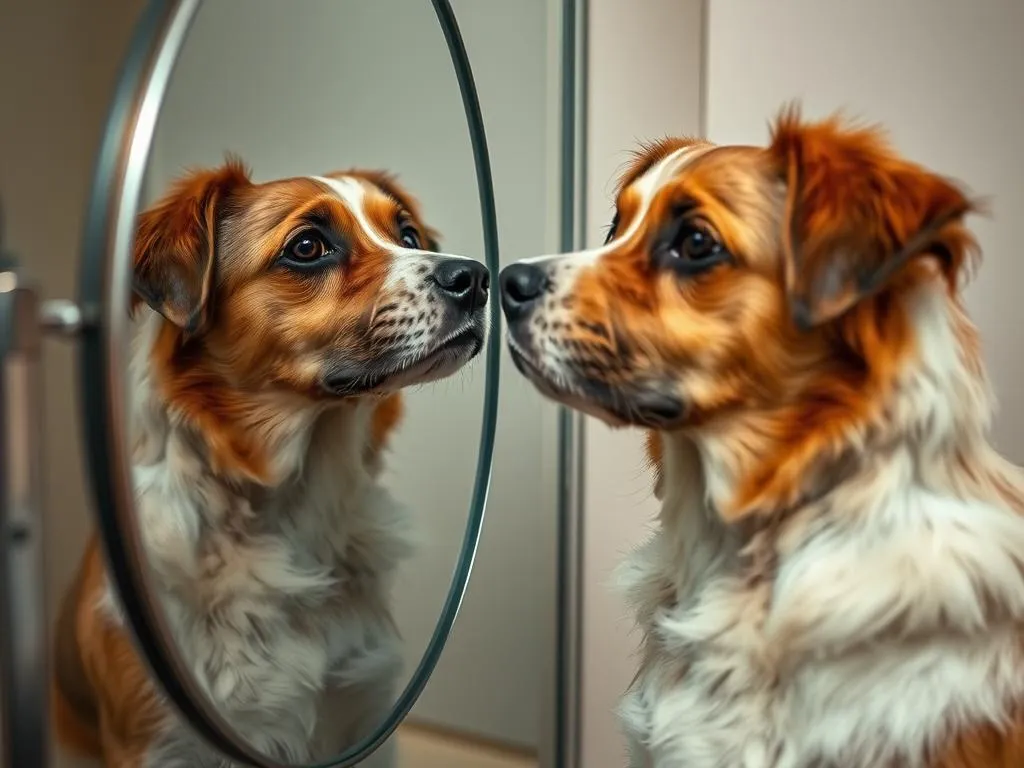
Introduction
Self-recognition is a fascinating topic in the realm of animal cognition and consciousness. While many animals demonstrate the ability to recognize themselves, dogs have often been left out of the conversation. This leads us to the pivotal question: can dogs recognize themselves in the mirror? Understanding this aspect of canine cognition is crucial for dog owners and trainers alike, as it sheds light on how dogs perceive their environment, interact with others, and understand themselves.
Understanding Self-Recognition
Definition of Self-Recognition
Self-recognition refers to an individual’s ability to identify themselves as distinct from others. This is often tested using the “mirror test,” where an animal is marked with a non-visible mark and then placed in front of a mirror. If the animal touches or investigates the mark on their own body after seeing it in the mirror, it indicates self-recognition.
Animal Cognition and Awareness
Animal cognition encompasses various mental processes, including perception, memory, and problem-solving. Certain species, such as great apes, dolphins, and elephants, have shown the ability to recognize themselves, suggesting a level of self-awareness. This recognition signifies not just intelligence but also a form of consciousness that allows for complex social interactions and emotional depth.
The Mirror Test: A Measure of Self-Recognition
History and Development of the Mirror Test
The mirror test was first developed by Gordon Gallup Jr. in 1970 and has since become a standard measure of self-recognition in animals. The test has been applied to various species, including primates, birds, and marine mammals, with differing results regarding their ability to recognize themselves.
Methodology of the Mirror Test
Conducting the mirror test involves several key steps:
- Marking: The animal is marked in a way that is only visible in a mirror.
- Observation: The animal is introduced to a mirror in a controlled environment.
- Response Assessment: Observers look for behaviors indicating self-recognition, such as touching the mark.
Different species may require variations of this test, tailored to their natural behaviors and abilities.
Limitations of the Mirror Test
While the mirror test is widely recognized, it has its limitations. Critics argue that the test may not accurately measure self-awareness across all species. Some animals may not use visual cues as their primary sense, leading to misleading results. Alternative methods, such as testing for empathy or problem-solving abilities, might provide a more comprehensive view of an animal’s cognitive capabilities.
Canine Behavior and Cognition
Overview of Canine Intelligence
Dogs are known for their remarkable ability to learn and interact with their environment. Their intelligence manifests in various ways, including problem-solving, emotional intelligence, and social interactions with humans and other animals. This intelligence raises the question of whether dogs possess self-recognition skills similar to those seen in other species.
Dogs and Mirrors: Observations and Studies
Research on dogs and their interactions with mirrors has yielded intriguing results. While some dogs show curiosity towards their reflection, others may react with confusion or indifference. A study by the University of California, San Diego, found that many dogs do not exhibit behaviors indicative of self-recognition when faced with a mirror. Instead, they may interpret their reflection as another dog or a novel object, leading to varied responses.
Factors Affecting Dogs’ Responses to Mirrors
Age and Development
A dog’s age can significantly influence its cognitive abilities and potential for self-recognition. Puppies, for instance, may not yet possess the maturity to understand mirrors, while older dogs may have a more developed sense of self. As dogs grow, their experiences and development can shape how they respond to reflective surfaces.
Breed Differences
Different breeds exhibit varying levels of intelligence and behavior, which can affect their interaction with mirrors. Breeds known for their problem-solving skills, such as Border Collies or Poodles, may display more curiosity towards their reflection compared to breeds that are less inclined to engage with their environment.
Early Socialization and Training
A dog’s early experiences and socialization play a crucial role in shaping its behavior. Dogs that are exposed to mirrors and reflective surfaces during their formative months may respond differently than those that are not. Proper training can also foster a better understanding of their environment, potentially enhancing their self-awareness.
Individual Personality Traits
Just as humans have unique personalities, so do dogs. A dog’s individual personality can heavily influence how it reacts to mirrors. Some dogs may exhibit curiosity, while others may feel threatened or confused. Understanding these personality traits can provide insights into a dog’s behavior in various situations.
Expert Opinions and Research Findings
Insights from Animal Behaviorists
Experts in animal cognition note that the absence of self-recognition in dogs does not imply a lack of intelligence or emotional depth. According to Dr. John Bradshaw, an animal behaviorist, dogs may possess a different form of self-awareness that is not dependent on visual recognition, suggesting that their understanding of themselves may manifest in other ways.
Summary of Relevant Research Studies
Research studies indicate that while many dogs do not pass the traditional mirror test, they may still demonstrate self-awareness through other behaviors. For instance, studies have shown that dogs can recognize their owners’ emotions through facial expressions, indicating a different level of awareness that does not rely solely on visual self-recognition.
Contrasting Views in the Field
The field of animal cognition is rife with differing opinions. Some researchers argue that the mirror test is inherently flawed and does not capture the full spectrum of self-awareness across species. Others maintain that it remains a valuable tool for understanding cognition in animals, including dogs.
Practical Implications for Dog Owners
Understanding Your Dog’s Behavior
Observing your dog’s reactions to mirrors can provide valuable insights into its personality and cognitive abilities. If your dog shows curiosity, it might indicate a higher level of engagement with its surroundings. Conversely, a dog that appears indifferent may require stimulation to enhance its cognitive development.
Training Techniques to Enhance Self-Awareness
Training can help dogs develop a better understanding of themselves and their environment. Techniques such as positive reinforcement and socialization with other animals can encourage curiosity and awareness. Incorporating mirrors into training sessions can also be beneficial, allowing dogs to explore their reflections in a safe and controlled manner.
Using Mirrors in Training and Play
Mirrors can serve as effective tools in training and play sessions. For example, using a mirror during agility training can help dogs understand their spatial awareness. Additionally, playful interactions involving a mirror can stimulate mental engagement, making training sessions more enriching.
Conclusion
The question of whether dogs can recognize themselves in the mirror remains a complex and nuanced topic. While research suggests that most dogs do not exhibit traditional self-recognition behaviors, this does not diminish their intelligence or emotional capability. Understanding canine behavior in relation to mirrors can enrich the bond between dogs and their owners, providing deeper insights into their cognitive and emotional worlds. By observing and engaging with their pets, dog owners can enhance their understanding of their dog’s unique personality and abilities.
Dogs may not see themselves in the same way that some other animals do, but their capacity for emotional connections and social interactions is a testament to their remarkable intelligence. As dog owners, fostering an environment that encourages exploration and curiosity can lead to a more fulfilling relationship with these incredible companions.









